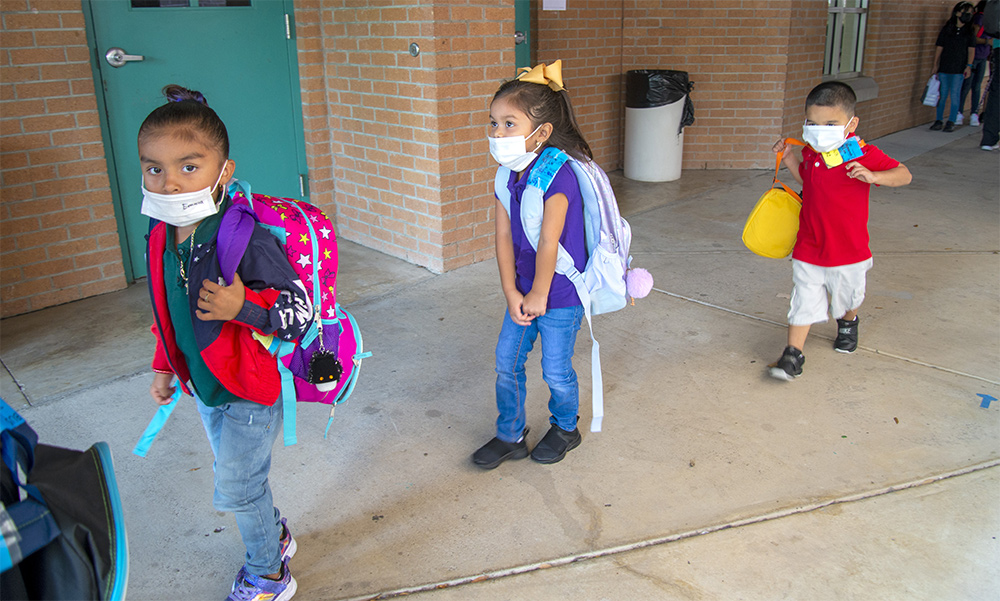While more students are returning to classrooms, many parents continue to keep their students home amid the delta variant’s climbing COVID-19 cases.
In San Benito, enrollment jumped to 9,338, up from about 8,300 last week.
“We’re trending up in a good direction,” school board member Ariel Ann Cruz said Tuesday.
In district offices, officials continue calling parents, urging them to send their children to school.
“We are on the phone calling parents about students not coming to class,” board member Oscar Medrano said.
This year, officials have been planning to return to full classroom schedules after some students fell behind during last year’s on-line learning programs.
While officials continue to take safety measures aimed at preventing the spread of COVID-19, they’re also offering students the vaccine.
“Our new school year began with the state-mandated live, in-person instruction for students across Texas. We find ourselves hopeful for the return to a normal learning environment,” Superintendent Nate Carman stated. “District and campus administrators will be implementing programs that will address accelerated instruction for learning loss and the academic impact of lost instructional time.”
Prospect of returning to on-line learning
However, the delta variant’s high COVID-19 levels are giving some officials second thoughts.
“The only way to do it is online,” Medrano said. “People are refusing to send their children to class due to COVID.”
Across the state, school officials are waiting for lawmakers to determine whether they’ll allow districts to offer on-line learning programs to students whose parents are keeping them home.
“If that becomes available, we’ll definitely look into that,” Cruz said, referring to Senate Bill 15.
Meanwhile, state officials are offering online learning programs aimed at students recovering from COVID-19 infections, Cruz said.
“San Benito CISD is currently delivering instruction through remote conferencing to minimize disruption of learning should a student be unable to attend school because of a temporary medical condition,” Carmen stated, adding, “the total amount of remote conferencing instruction does not exceed more than 20 instructional days over the entirety of the school year.”
Harlingen finalizing enrollment numbers
In Harlingen, district officials have declined to release enrollment figures for the last two weeks, waiting for student numbers to become “finalized” on Friday.
Last year, enrollment dropped to 17,756, down from 18,399 during the 2019-2020 school year.
Across the state, student attendance helps fund districts’ education programs.
Based on a formula, many Valley districts stand to lose about $5,500 a day in state funding for every student who doesn’t show up for class.
Facing budget crunches, districts have been turning to the federal Elementary and Secondary School Emergency Relief Fund, or ESSER, to try to offset losses.
Raymondville working to boost numbers
In Raymondville, parents kept about 200 students home Tuesday, a day after about a fourth of students didn’t show up on two campuses for the opening of the school year.
“We’re going to see changes in our numbers,” John Solis, the school board’s president, said. “I know our staff has been working diligently to make sure kids go to class.”
On Tuesday, enrollment stood at about 2,000, Ben Clinton, the district’s deputy superintendent, said.
Officials are counting on a mask mandate and technology aimed at killing pathogens including the coronavirus to help lead parents to send their children back to the classroom.
“I think people are hesitant a little bit but we’ve been talking to them,” Clinton said, referring to parents who continue to keep their children home. “As we talk to parents, we’re explaining our protocols.”
Officials planning to go ahead with full classroom schedules
Despite drops in enrollment, officials are planning to go ahead with full classroom schedules, Solis said.
“They’re going to be in the classroom getting help from teachers,” he said, referring to the district’s return to full classroom schedules.
Last year, some students fell behind taking on-line learning programs.
“I believe the vast majority of school districts find kids weren’t really learning at home,” Solis said. “Our area’s infrastructure for internet isn’t up to speed.”
So far, officials are mandating students and faculty wear facial coverings to help protect against COVID-19.
“We’re going to make sure masks are being worn and sanitizers are out there,” Solis said.
Last year, officials spent $626,000 to purchase needlepoint bipolar ionization technology they installed in air-conditioning and heating units to kill pathogens including the coronavirus.
“I’m very comfortable we have clean air in schools. We did not have one case of the virus that started in school,” Solis said, referring to last year.
At school, officials are offering students the COVID-19 vaccine.
“We’ve been offering to vaccinate our kids,” Clinton said. “We’re still going to offer it as long as they want to do it.”





